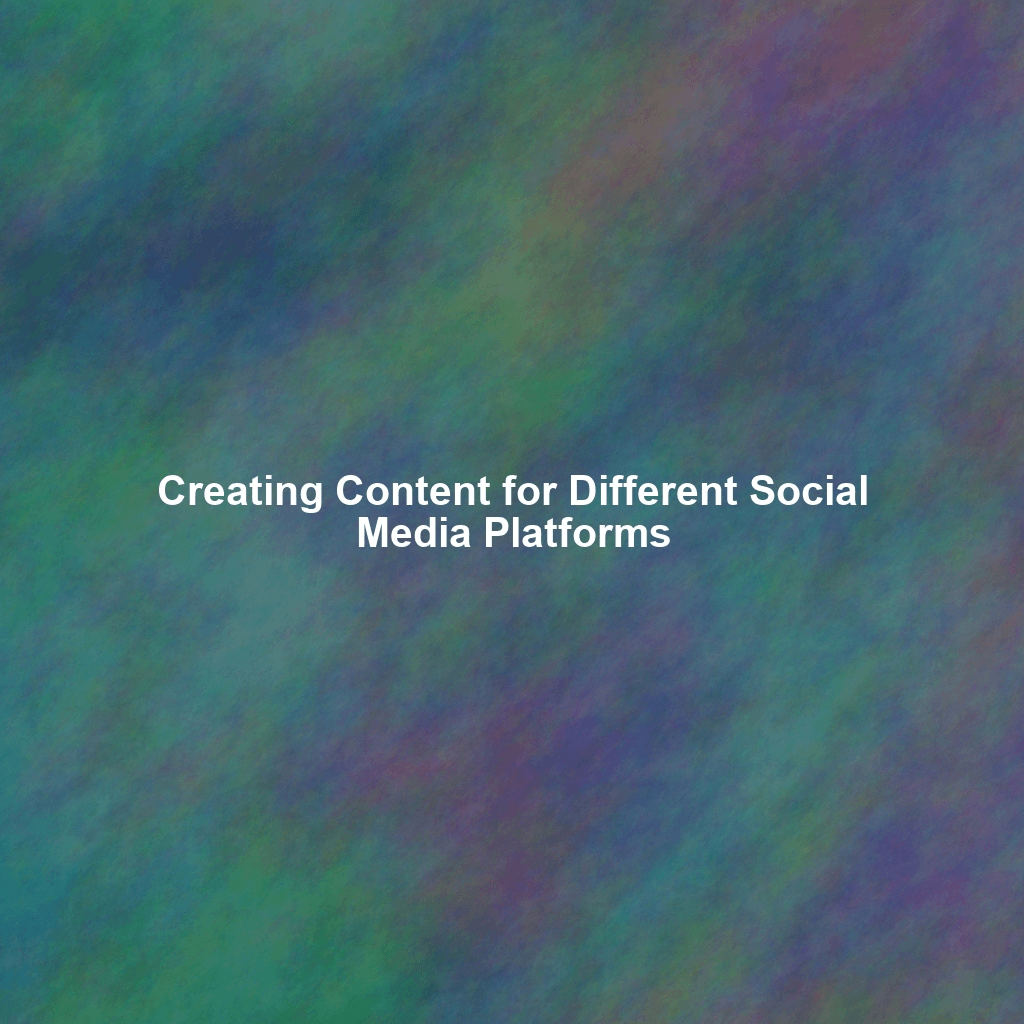The Art of Tailoring: Why Platform-Specific Content Matters
This article delves into the intricacies of crafting content that resonates with the distinct audiences, formats, and cultures of various social media platforms. We’ll explore how to optimize your content strategy to maximize engagement, build brand awareness, and ultimately, drive conversions.
Understanding Your Audience: The Foundation of Effective Content
Before diving into the specifics of each platform, it’s crucial to establish a deep understanding of your target audience. Who are you trying to reach? What are their interests, pain points, and online behaviors? Conducting thorough audience research is paramount to crafting content that truly resonates.
Consider creating detailed buyer personas that represent your ideal customers. These personas should include demographics, psychographics, motivations, and preferred social media platforms. Use this information to inform your content creation process, ensuring that your message speaks directly to your target audience.
Leveraging Analytics for Audience Insights
Don’t rely solely on assumptions. Utilize social media analytics tools to gather data on your audience’s engagement with your existing content. Analyze metrics such as likes, shares, comments, and click-through rates to identify what’s working and what’s not. This data-driven approach will help you refine your content strategy and optimize it for maximum impact.
Platform-Specific Content Strategies: A Deep Dive
Now, let’s explore the specific nuances of creating content for some of the most popular social media platforms:
Facebook: Building Community and Fostering Engagement
Facebook, with its massive user base, offers a vast opportunity to connect with your target audience. However, the platform’s algorithm prioritizes content from friends and family, making it challenging to stand out. To succeed on Facebook, focus on creating engaging content that encourages interaction and fosters a sense of community.
- Content Types: Share a mix of text updates, images, videos, and live streams. Consider running contests and giveaways to boost engagement.
- Tone: Maintain a friendly and approachable tone. Focus on building relationships with your followers.
- Length: Keep your posts concise and visually appealing. Use short paragraphs and compelling images or videos to capture attention.
- Call to Action: Include clear calls to action that encourage users to like, comment, share, or visit your website.
Instagram: Visual Storytelling and Aspirational Content
Instagram is a visually driven platform that thrives on high-quality images and videos. To succeed on Instagram, focus on creating visually stunning content that tells a compelling story and aligns with your brand’s aesthetic.
- Content Types: Share high-quality photos and videos, Reels (short-form videos), and Stories (ephemeral content that disappears after 24 hours).
- Tone: Maintain a stylish and aspirational tone. Focus on showcasing your brand’s personality and values.
- Length: Keep your captions concise and engaging. Use relevant hashtags to increase visibility.
- Call to Action: Encourage users to follow your account, like your posts, and visit your website (using the link in your bio).
Twitter: Real-Time Updates and Thought Leadership
Twitter is a fast-paced platform that thrives on real-time updates and thought leadership. To succeed on Twitter, focus on sharing timely and relevant information that sparks conversations and positions you as an authority in your industry.
- Content Types: Share short, concise text updates, links to articles and blog posts, and engaging GIFs and videos.
- Tone: Maintain a professional and informative tone. Focus on sharing valuable insights and engaging in relevant conversations.
- Length: Keep your tweets concise and to the point. Use relevant hashtags to increase visibility.
- Call to Action: Encourage users to retweet your posts, follow your account, and click on your links.
LinkedIn: Professional Networking and Industry Insights
LinkedIn is the premier platform for professional networking and industry insights. To succeed on LinkedIn, focus on sharing valuable content that demonstrates your expertise and connects you with other professionals in your field.
- Content Types: Share articles, blog posts, industry news, and updates on your company’s achievements.
- Tone: Maintain a professional and authoritative tone. Focus on sharing valuable insights and engaging in thoughtful discussions.
- Length: Share longer-form articles and posts that provide in-depth analysis and insights.
- Call to Action: Encourage users to connect with you, follow your company page, and engage in discussions.
YouTube: Video Content and Long-Form Engagement
YouTube is the leading video platform, ideal for showcasing demonstrations, tutorials, and in-depth content that fosters a deeper connection with your audience.
- Content Types: Tutorials, demonstrations, vlogs, product reviews, interviews, and live streams.
- Tone: Adapt the tone to the content, but authenticity and genuine engagement are key.
- Length: Optimize video length based on content type. Short, engaging content or longer, in-depth tutorials.
- Call to Action: Encourage subscriptions, likes, comments, and sharing. Use end screens and cards to promote related videos or external links.
TikTok: Short-Form Video and Trends
TikTok is a short-form video platform, popular for its trendy, fast-paced content. Creativity and understanding of current trends are crucial.
- Content Types: Short, engaging videos, often set to music or sound effects. Participate in trending challenges.
- Tone: Lighthearted, fun, and authentic.
- Length: Typically 15-60 seconds, but can be up to 3 minutes. Shorter videos generally perform better.
- Call to Action: Encourage follows, likes, comments, and participation in challenges.
Pinterest: Visual Discovery and Inspiration
Pinterest is a visual discovery engine, where users find inspiration for projects, ideas, and purchases. It’s excellent for driving traffic and showcasing visually appealing products or services.
- Content Types: High-quality images and infographics.
- Tone: Inspirational, visually appealing, and helpful.
- Length: Pin descriptions should be concise and keyword-rich.
- Call to Action: Drive traffic to websites or product pages. Encourage users to save pins to their boards.
Optimizing Content for Search Engines: A Crucial Step
While tailoring content for each platform is essential, don’t forget about search engine optimization (SEO). Optimizing your content for relevant keywords will help it rank higher in search results and drive organic traffic to your social media profiles.
Conduct keyword research to identify the terms your target audience is searching for. Incorporate these keywords naturally into your titles, descriptions, and hashtags. Use relevant keywords in your image alt text to improve accessibility and search engine visibility.
Leveraging Hashtags for Increased Visibility
Hashtags are a powerful tool for increasing the visibility of your content on social media. Use relevant hashtags to categorize your posts and make them easier for users to find. Research popular hashtags in your niche and incorporate them into your content strategy. However, avoid using too many hashtags, as this can make your posts appear spammy.
Measuring and Analyzing Results: Continuously Improve Your Strategy
Content marketing is an iterative process. To ensure the success of your social media strategy, it’s crucial to track your results and make adjustments as needed. Monitor key metrics such as engagement, reach, and website traffic to assess the effectiveness of your content.
Use social media analytics tools to identify what’s working and what’s not. Analyze your data to identify trends and patterns. Use this information to refine your content strategy and optimize it for maximum impact. Regularly review your audience insights, platform performance, and keyword rankings to stay ahead of the curve and ensure that your content continues to resonate with your target audience.
Conclusion: Embrace the Power of Platform-Specific Content
In the dynamic realm of content marketing, a one-size-fits-all approach is no longer sufficient. By understanding the unique nuances of each social media platform and tailoring your content accordingly, you can unlock the true potential of your content marketing strategy. Embrace the power of platform-specific content, and watch your engagement, brand awareness, and ultimately, your business, flourish.
 Skip to content
Skip to content

